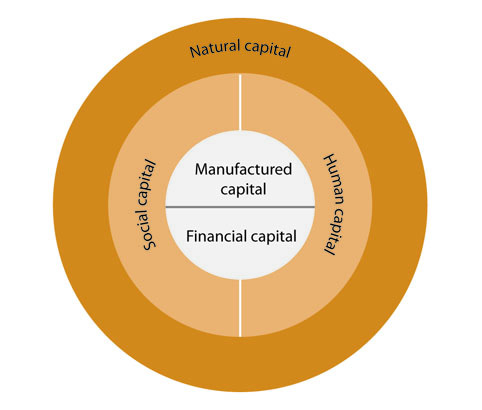The role of the environment
Good information on the health of the natural environment is at least as important as information about public health and the economy because the health and wellbeing of people, the environment and the economy are inextricably linked and interdependent. The economy is dependent on finite natural resources (renewable and nonrenewable) and essential ecosystem goods and services; our quality of life is influenced by a healthy economy and also relies directly and indirectly on healthy environmental conditions and ecosystem services (Millennium Ecosystem Assessment 2005).
Ecosystem goods and services are the benefits arising from the ecological functions of healthy ecosystems. Ecosystem goods and services include (Costanza et al. 1997, CBD 2010):
- goods (provisioning services)
- food, fibre and fuel
- genetic resources
- biochemicals (e.g. medicines)
- fresh water
- breathable air
- cultural services
- spiritual and religious values
- knowledge system
- education and inspiration
- recreation and aesthetic values
- regulating services
- invasion resistance
- herbivory
- pollination
- seed dispersal
- climate regulation
- pest regulation
- disease regulation
- natural hazard protection
- erosion regulation
- water purification
- supporting services
- primary production
- provision of habitat
- nutrient cycling
- soil formation and retention
- production of atmospheric oxygen
- water cycling
- waste treatment.
The important interrelationship between the environment and human society can be viewed as a set of stocks, divided into five essential capitals: natural (ecosystem services), social (networks, consensus), human (knowledge, labour), manufactured (tradeable goods, public infrastructure) and financial (wealth). As represented in Figure 1, all of these capitals and their stocks are linked (with flows and transfers of energy, matter and information between them). For the system to operate optimally, it needs sufficient availability of, and freedom to move and price, all capitals, and trading mechanisms to facilitate exchange. The figure also reflects that there is a finite stock of natural capital within which the other capitals can accumulate.
People believe environmental ‘bads’ are the price we must pay for economic ‘goods.’ However, we cannot, and need not, continue to act as if this trade-off is inevitable. (Achim Steiner, UNEP Executive Director and UN Under Secretary-General, UNEP 2011)

Source: Forum for the Future (2013)
Figure 1 Five essential capitals for human wellbeing